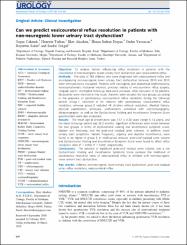Can we predict vesicoureteral reflux resolution in patients with non-neurogenic lower urinary tract dysfunction?

Göster/
Tarih
2019Yazar
Çakmak, ÖzgürTarhan, Hüseyin
Akarken, İlker
Doğan, Hasan Serkan
Yavaşcan, Önder
Şahin, Hayrettin
Tekgül, Serdar
Üst veri
Tüm öğe kaydını gösterÖzet
Objective To analyze factors influencing reflux resolution in patients with the coexistence of non-neurogenic lower urinary tract dysfunction and vesicoureteral reflux. Methods The data of 153 children who were diagnosed with vesicoureteral reflux and accompanying non-neurogenic lower urinary tract dysfunction between 2010 and 2015 were retrospectively evaluated. Patients with neurogenic and anatomical malformations, monosymptomatic nocturnal enuresis, previous history of vesicoureteral reflux surgery, irregular and/or incomplete follow-up data were excluded. After exclusion of 55 patients, 98 patients were enrolled in this study. Patients were divided into two groups according to the presence of spontaneous vesicoureteral reflux resolution during the follow-up period. Group 1 consisted of 54 children with spontaneous vesicoureteral reflux resolution, whereas group 2 included 44 children without resolution. Medical history, physical examination, urinalysis, uroflowmetry combined with electromyography, ultrasonography, as well as the Dysfunctional Voiding and Incontinence Symptom Score questionnaire were also evaluated. Results The mean age at presentation was 7.57 +/- 0.23 years (range 5-13 years), and the mean follow-up period was 28.3 months. Significant differences were noted between the two groups in terms of dysfunctional voiding and incontinence symptom score, bladder wall thickness, and the post-void residual urine volumes. In addition, lower urinary tract symptoms, namely frequency, urgency and daytime incontinence, were found to be higher in group 2. In multivariate analysis, post-void residual urine volume and Dysfunctional Voiding and Incontinence Symptom Score were found to affect reflux resolution rates (P = 0.002, P = 0.002, respectively). Conclusions The absence of significant post-void residual urine volume, and a low Dysfunctional Voiding and Incontinence Symptom Score increase the likelihood of spontaneous resolution rates of vesicoureteral reflux in children with non-neurogenic lower urinary tract dysfunction.

















